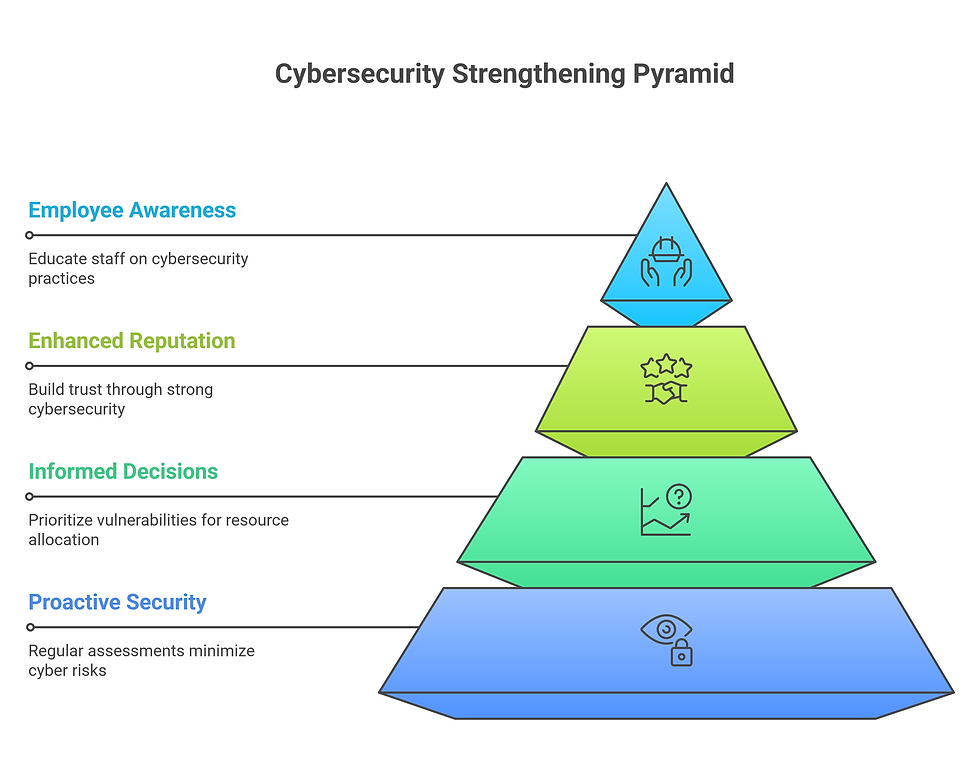Uncovering Vulnerability: How Assessments Can Empower SMBs
- CyberShield NXT

- Jul 1
- 4 min read
Updated: Jul 7
In today's fast-paced digital world, small and medium-sized businesses (SMBs) face a range of cybersecurity challenges. With 43% of cyber attacks targeting small businesses, it is vital for these organizations to identify and fix their security weaknesses.
One effective strategy for achieving this is through vulnerability assessments. This article explores why vulnerability assessments matter, the different types available, and how they can significantly enhance the cybersecurity stance of SMBs.
Understanding Vulnerability Assessment
A vulnerability assessment is a systematic examination of an organization's security systems and practices. Its purpose is to identify, evaluate, and prioritize weaknesses in networks, applications, or systems.
For example, if a small business uses outdated software, it might be an open door for cyber attackers. Regular assessments help organizations understand these risks and take steps to manage them.
Conducting regular vulnerability assessments is crucial. They provide key insights into threats and allow organizations to protect sensitive data while remaining compliant with industry regulations, such as HIPAA or PCI DSS.
Types of Vulnerability Assessments
Organizations have various options for vulnerability assessments based on their unique needs:

1. Network Vulnerability Assessment
This assessment concentrates on identifying weaknesses within an organization’s network. It scans for misconfigurations, outdated software, and other security flaws. For instance, a network analysis might reveal that 30% of devices are running outdated software, directly exposing the organization to potential breaches.
2. Web Application Vulnerability Assessment
Web applications often attract cyber threats. This type of assessment evaluates those applications for vulnerabilities like cross-site scripting (XSS) and SQL injection attacks. Interestingly, studies show that nearly 90% of organizations have at least one vulnerable web application.
3. Host-Based Vulnerability Assessment
This assessment identifies vulnerabilities in individual devices on a network, such as servers and workstations. It checks for issues like missing security patches, which, if overlooked, could leave significant gaps in an organization’s defense.
4. Wireless Network Vulnerability Assessment
Wireless networks are especially exposed to attacks. This assessment examines the wireless infrastructure for weaknesses like weak encryption standards. For example, SMBs might discover that nearly 40% of their wireless networks are not utilizing adequate encryption.
5. Social Engineering Assessment
Often underestimated, social engineering can lead to serious data breaches. This assessment evaluates employees' susceptibility to tactics like phishing. Research shows that nearly 50% of employees might click on a suspicious link, emphasizing the need for awareness and training.
Practical Applications for Vulnerability Assessments in SMBs
Vulnerability assessments can be invaluable for SMBs in various scenarios:
1. Compliance
Many industries mandate specific compliance standards. Regular vulnerability assessments help SMBs meet these regulations by identifying security gaps and ensuring the implementation of necessary security measures.
2. Risk Management
Identifying vulnerabilities enables SMBs to manage cybersecurity risks better. By understanding which assets are most at risk, organizations can invest strategically in security resources. For instance, an SMB might allocate 30% of its IT budget to address the most critical vulnerabilities first.
3. Incident Response Planning
When a cyber incident occurs, tailored knowledge of vulnerabilities aids quick response. SMBs can create effective incident response plans based on assessment findings, helping them minimize serious damage.
4. Cost Savings
Addressing vulnerabilities early can avert expensive data breaches. Research shows that the average cost of a data breach for small businesses is approximately $200,000. Regular assessments can help save significant money by avoiding potential losses and preserving customer trust.
Strengthening Cybersecurity through Vulnerability Assessments
Vulnerability assessments deliver profound benefits, strengthening the cybersecurity landscape of SMBs:
1. Proactive Security Approach
Regular assessments foster a proactive attitude toward cybersecurity. By continuously identifying and addressing weaknesses, SMBs can stay ahead of cybercriminals and minimize risks.
2. Informed Decision-Making
The insights gained from assessments enable SMBs to make informed decisions regarding security innovations and practices. For instance, prioritizing vulnerabilities based on risk levels ensures resources are allocated effectively.

3. Enhanced Reputation
A commitment to solid cybersecurity builds trust with clients and stakeholders. Organizations that prioritize their security are often recognized as more reliable, potentially opening doors to new business opportunities.
4. Increased Employee Awareness
Vulnerability assessments promote cybersecurity education among employees. Understanding vulnerabilities helps staff adopt safer practices and recognize warning signs of potential threats.
Navigating the Challenges of Vulnerability Assessments
Despite their many benefits, vulnerability assessments come with challenges:
1. Resource Limitations
Many SMBs struggle with limited resources and expertise in conducting thorough assessments. Engaging external consultants or utilizing automated tools can alleviate these constraints.
2. Evolving Threat Landscape
Cyber threats constantly evolve, which requires organizations to conduct regular assessments proactively. However, keeping pace with emerging vulnerabilities can be challenging without dedicated resources.
3. Managing Assessment Results
Sometimes, the findings from an assessment can be overwhelming, especially if numerous vulnerabilities are discovered. It is essential to develop a structured plan for addressing issues gradually and effectively.
Wrapping Up
Vulnerability assessments are crucial for SMBs eager to bolster their cybersecurity posture. By identifying and prioritizing vulnerabilities, businesses can take proactive steps to safeguard sensitive information and retain customer trust. While challenges might arise, the advantages significantly outweigh the setbacks. SMBs embracing vulnerability assessments equip themselves to confidently navigate the complexities of the cybersecurity landscape.
In a digital environment fraught with risks, regular assessments and informed security measures can transform vulnerabilities into opportunities for growth and resilience. This vital step not only fortifies an organization’s defenses but also paves the way for a secure and prosperous future.








Comments